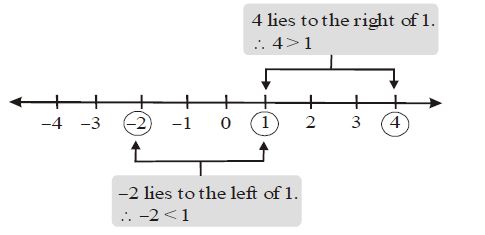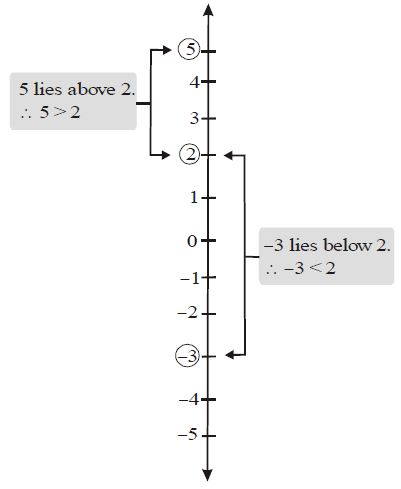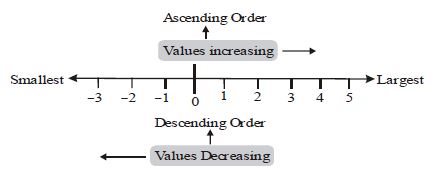1. INTEGERS
Numbers greater than 0 are called positive numbers. Extending the number line to the left of 0 allows us to picture negative numbers, numbers that are less than 0.

When a single + sign or no sign is in front of a number, the number is a positive number. When a single
– sign is in front of a number, the number is a negative number.
– 5 indicates “negative five”. 5 and + 5 indicate “positive five”.
The number 0 is neither positive nor negative.
Reading and writing integers
The sign of an integer is read first before the number.
Example: – 5 is read as ‘negative five’. + 9 is read as ‘positive 9’ or simply ‘nine’.
0 is an integer but it is nothing positive nor negative.
2. REPRESENTING INTEGERS ON NUMBER LINES
Integers can be represented on a number line.
The number line shows that every integer has an opposite number except ‘0’.
Comparing the Values of Two Integers
Number line can be used to compare the values of two integers.
1. Horizontal number line
(A) On a horizontal number line, an integer is greater than the integer on its left.
(B) On a horizontal number line, an integer is less than the integer on its right.
2. Vertical number line
(A) On a vertical number line, an integer is greater than the integer below it.
(B) On a vertical number line, an integer is less than the integer above it.
3. ORDERING OF INTEGERS
1. Number lines can be used to arrange order, integers in increasing or decreasing order.
2. The value of integers on a horizontal number line increases from left to right and decreases from right to left.
IV. Writing Positive and Negative Integers to Represent Word Descriptions
1. A positive or negative number is used to denote:
(A) An increase or a decrease in value
Examples:
(I) Rs.70 withdrawn is denoted by –Rs. 70.
(ii) Rs.70 deposited is denoted by + Rs.70.
(B) Values more than zero values less than zero
(I) – 18 denotes a temperature that is 18 below 0 .
(ii) +18 denotes a temperature that is 18 above 0 .
(C) A positive direction or a negative direction (opposite direction)
Examples:
(I) –20 denotes an anticlockwise rotation of .
(ii) +20 denotes a clockwise rotation of .
(iii) +5 m denotes a direction 5 m to the right.
(iv) –5 m denotes a direction 5 m to the left.
(D) Position above or below sea level
(I) Sea level is taken as 0 m.
(ii) If a bird flies 350 m above sea level, we write it as +350 m.
(iii) If the submarine lies 150 m below sea level and write it as –150 m.
4. ADDITION AND SUBTRACTION OF INTEGERS
(a) When we have the same sign, add and put the same sign.
(i) When two positive integers are added, we get a positive integer
[e.g. (+ 3) + ( + 2) = + 5].
(ii) When two negative integers are added, we get a negative integer
[e.g. (–2) + ( – 1) = – 3].
(b) When one positive and one negative integers are added we subtract them and put the sign of the bigger integer. The bigger integer is decided by ignoring the signs of the integers [e.g. (+4) + (–3) = + 1 and (–4) + ( + 3) = – 1].
(c) The subtraction of an integer is the same as the addition of its additive inverse.
Addition of integers on a number line
Let us add 3 and 5 on number line.
On the number line, we first move 3 steps to the right from 0 reaching 3, then
we move 5 steps to the right of 3 and reach 8. Thus, we get 3 + 5 = 8
Subtraction of integers on a number line
Let us subtract 2 from 6 on number line.
we can start from 6 and then move 2 steps to the left of 6. We reach at 4. So, we have, 6 + (–2) = 4
5. PROPERTIES OF INTEGERS ON ADDITION AND SUBTRACTION
(A) If a and b are two integers then
a + b = c
where c is also an integer.
(B) For any two integers a and b
a + b = b + a
Which means that if we change the order of the integers, even then their sum does not change.
(C) For any three integers a, b and c
(a + b) + c = a + (b + c)
This means that even if we rearrange the integers their sum does not change.
(D) If a is any integer then a + 0 = a
This means that the sum of any integer and zero is the integer itself.
e.g. – 10 + 0 = – 10
6 + 0 = 6
– 15 + 0 = – 15
(E) For every integer a (which is not zero)there is another integer – a such that
a + (– a) = 0
e.g. 3 + (– 3) = 0
5 + (– 5) = 0
6 + (– 6) = 0
(F) The difference of any two integers is an integer i.e. If a and b are two integers then a – b = c, where c is also an integer.
(G) In the whole numbers, 0 has no predecessor. But in integers – 1 is the predecessor of 0, –2 is the predecessor – 1 and so on.
Thus if a is any integer, then
a – 1 is its predecessor.
(H) If a is any integer then
a – 0 = a
Like signs Unlike signs
+ (+y) = +y + (– y) = – y
– (–y) = + y – (+ y) = – y








